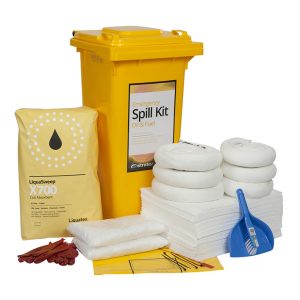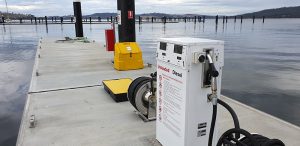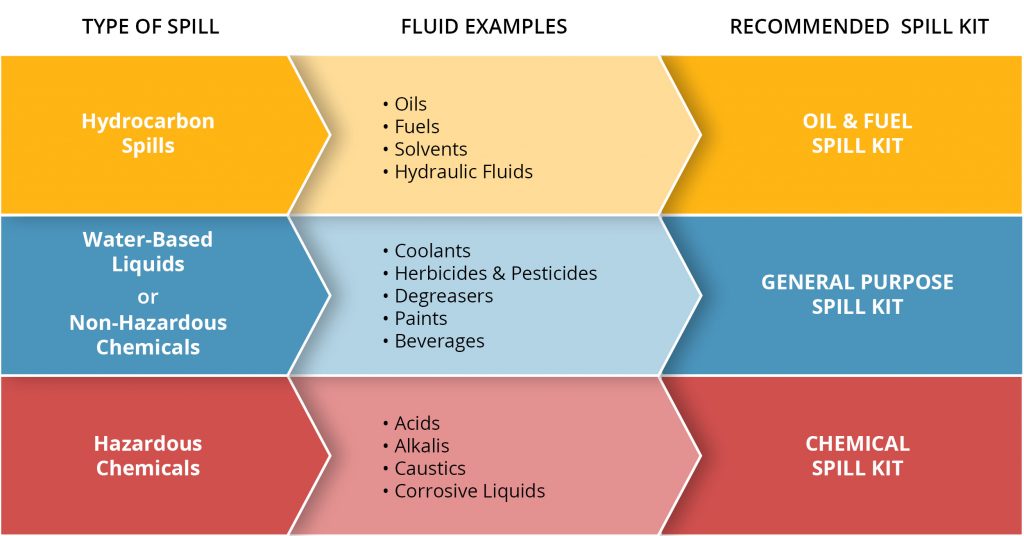
Do I need a Spill Kit?
If you work in an industry that handles or stores any liquids with a potential to spill, having a spill kit available is good practice. If any of these liquids are hazardous in nature, Australian regulations and standards require you to keep a suitable spill kit onsite. Being prepared for spills is essential in securing a safe working environment and in this article we’re going to help you identify whether you need a spill kit and if so, which will suit your needs.
What types of liquids?
Not all fluid spills in the workplace will be hazardous liquids, however they can still be a slip hazard and require clean up. Smaller spills, leaks and drips can often be cleaned without deploying a spill kit. Stratex has absorbent rolls and pads that are available in handy dispensers to manage day to day spills, leaving your spill kit fully-stocked for emergencies. For large and emergency hazardous liquid spills, a suitable spill kit is essential. Understanding which types of liquids that are stored and handled will help you in selecting the correct kit for your workplace.
Note: if you are ever unsure as to what type of fluid has been spilled, using a chemical spill kit is recommended.
What size spill kit do I need?
It’s good practice to select a spill kit that can absorb your maximum likely spill, rather than your total liquid onsite. For example, if your largest fluid containers are 200 litre drums, your spill kits should have at least 200 litres of total absorbent capacity. Also consider how quickly you can respond to spills across a large area – wheeled bin kits stored in multiple locations may be more effective than a single locker spill kit.
Spill kit components

120L Oil & Fuel Spill Kit is ideal for outdoor use. SKU: K26-4212P
Most spill kits will contain the same key components:
- Absorbent socks are used around the spill to stop the spread and contain the area.
- Absorbent cushions can be placed under drips and used to absorb pooled liquid.
- Absorbent pads are ideal for usage on sealed surfaces (such concrete and painted floors)
- Granular absorbents are best suited to unsealed or rough surfaces (such as gravel and bitumen)
- Contaminated waste disposal bags for safe disposal of the contaminated waste.
- Personal Protective Equipment including gloves, eyewear and coveralls.
Note the composition of these components will differ depending on the type of kit.
Where will it be used?
If your spill is likely to occur outdoors or in a marine environment, an oil and fuel spill kit is recommended. Absorbents in these kits will float on water, soaking up oils and fuels on the surface. Similarly any spills will not be affected by rain or puddles.
For indoor use, general purpose and chemical spill kits can absorb almost all fluids, reducing any potential slip hazards.
In Summary
- General Purpose Spill Kits (Blue Bin) – will absorb all fluids, with the exception of aggressive acids or alkalis. Not suitable for marine spills.
- Chemical Spill Kits (Red Bin) – will absorb all fluids and come packed in a red bin to highlight the dangers that a chemical spill can present.
- Oil and Fuel Spill Kits (Yellow Bin) – will absorb fuels and oils, and are ‘hydrophobic’, meaning they will not absorb water. Suitable for marine spills.
Stratex stocks a wide range of wheeled bin, carry bag, locker spill kits and trailers – we can also customise a solution to suit your unique requirements.
To find out more contact us on 1300 991 180 or email [email protected].

Oil and fuel spill kits can be used to absorb diesel spills on water.
Looking for a specialised spill kit? Stratex also offer bio hazard, acid and alkali, cytotoxic and body fluid spill kits, ideal for healthcare use. Click the link to see our full range below.
-
120L Wheeled Bin Standard Spill Kit – General Purpose
The Standard Range of Spill Kits are designed for indoor and outdoor spills on both sealed and unsealed surfaces. These can include sealed surfaces such as asphalt, concrete or metal, and also unsealed surfaces such as dirt or gravel. To ensure you can handle any spill incident, they contain a range of absorbents from pads, socks, cushions to granular absorbent.
Stratex Spill Kits are an integral part of compliance with Australian standards and regulations, and our absorbents are quality tested.
-
120L Wheeled Bin Standard Spill Kit – Oil & Fuel
The Standard Range of Spill Kits are designed for indoor and outdoor spills on both sealed and unsealed surfaces. These can include sealed surfaces such as asphalt, concrete or metal, and also unsealed surfaces such as dirt or gravel. To ensure you can handle any spill incident, they contain a range of absorbents from pads, socks, cushions to granular absorbent.
Stratex Spill Kits are an integral part of compliance with Australian standards and regulations, and our absorbents are quality tested.
-
120L Wheeled Bin Standard Spill Kit – Chemical
The Standard Range of Spill Kits are designed for indoor and outdoor spills on both sealed and unsealed surfaces. These can include sealed surfaces such as asphalt, concrete or metal, and also unsealed surfaces such as dirt or gravel. To ensure you can handle any spill incident, they contain a range of absorbents from pads, socks, cushions to granular absorbent.
Stratex Spill Kits are an integral part of compliance with Australian standards and regulations, and our absorbents are quality tested.
-
240L Wheeled Bin Standard Spill Kit – General Purpose
The Standard Range of Spill Kits are designed for indoor and outdoor spills on both sealed and unsealed surfaces. These can include sealed surfaces such as asphalt, concrete or metal, and also unsealed surfaces such as dirt or gravel. To ensure you can handle any spill incident, they contain a range of absorbents from pads, socks, cushions to granular absorbent. Stratex Spill Kits are an integral part of compliance with Australian standards and regulations, and our absorbents are quality tested.
-
240L Wheeled Bin Standard Spill Kit – Oil & Fuel
The Standard Range of Spill Kits are designed for indoor and outdoor spills on both sealed and unsealed surfaces. These can include sealed surfaces such as asphalt, concrete or metal, and also unsealed surfaces such as dirt or gravel. To ensure you can handle any spill incident, they contain a range of absorbents from pads, socks, cushions to granular absorbent. Stratex Spill Kits are an integral part of compliance with Australian standards and regulations, and our absorbents are quality tested.
-
240L Wheeled Bin Standard Spill Kit – Chemical
The Standard Range of Spill Kits are designed for indoor and outdoor spills on both sealed and unsealed surfaces. These can include sealed surfaces such as asphalt, concrete or metal, and also unsealed surfaces such as dirt or gravel. To ensure you can handle any spill incident, they contain a range of absorbents from pads, socks, cushions to granular absorbent.
Stratex Spill Kits are an integral part of compliance with Australian standards and regulations, and our absorbents are quality tested.
-
30L Carry Bag Spill Kit – General Purpose
Our most popular vehicle spill kit comes in a compact hi-vis carry bag, small enough to store in truck cabs or toolboxes, behind a door, placed in a laboratory cupboard, in a delivery van or behind Ute seats. Packed with a range of absorbents designed to contain and clean up all small spills. These kits are designed to be taken anywhere, with a strong handle for easy portability from vehicle to spill site. The 30 Litre Spill Kit contains absorbent socks to encircle spills and protect drains and absorbent pads and cushions to absorb the bulk of spilled liquid. It also contains highly versatile granular absorbent which enables it to absorb spills on both sealed surfaces such as concrete and asphalt, and unsealed surfaces such as gravel and dirt. Personal protective equipment and contaminated waste disposal bags are included for clean-up and disposal. It includes a laminated instruction card for usage guidance, and a reorder form for easy restocking. Stratex Spill Kits are an integral part of compliance with Australian standards and regulations, and our absorbents are quality tested.
-
50L Carry Bag Spill Kit – General Purpose
These spill kits are a compact, all-in-one kit designed especially for protecting your mobile workforce. They provide fast emergency response to any spill situation, and only take up a small space in larger machinery including trucks, excavators, cranes and drilling rigs. The 50 Litre Spill Kit comes packed in a heavy-duty, re-sealable bag and has handles for easy portability from vehicle to spill site.
It contains absorbent socks to encircle spills and protect drains and absorbent pads and cushions to absorb the bulk of spilled liquid. It also contains highly versatile granular absorbent which enables it to absorb spills on both sealed surfaces such as concrete and asphalt, and unsealed surfaces such as gravel and dirt.
Personal protective equipment and contaminated waste disposal bags are included for clean-up and disposal. It includes a laminated instruction card for usage guidance, and a reorder form for easy restocking.
Stratex Spill Kits are an integral part of compliance with Australian standards and regulations, and our absorbents are quality tested.
AVAILABLE IN:
Stratex 50 Litre General Purpose Spill Kit | K24-3050
Stratex 50 Litre Oil & Fuel Spill Kit | K24-3250
Stratex 50 Litre Chemical Spill Kit | K24-3450
































